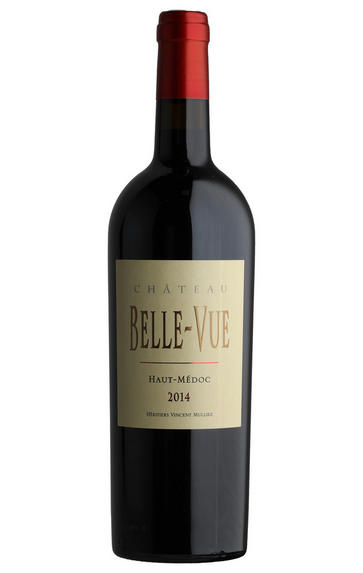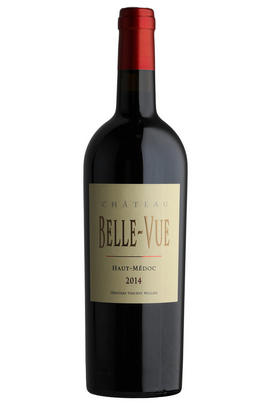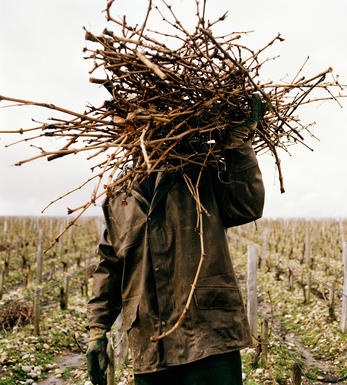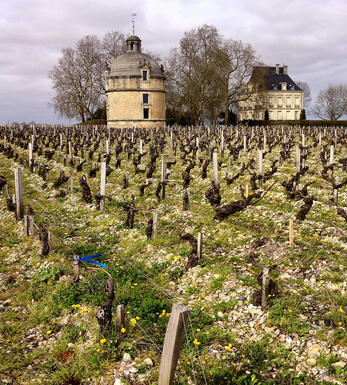
2014 Château Belle-Vue, Haut-Mèdoc, Bordeaux

Critics reviews
An absolutely striking Haut-Médoc, the 2014 Belle-Vue is just as impressive from bottle as it was from barrel. The flavors are dark and sumptuous in a wine that offers notable intensity and persistence throughout. The high %age of Petit Verdot adds to the wine's unique personality. The 2014 has gained in darkness and volume over the last two years, but it is every bit as delicious as it has always been. This is a very serious Haut-Médoc.
The blend is 47 % Cabernet Sauvignon, 31 % Merlot and 22 % Petit Verdot that spent 30 days on the skins followed by malolactic fermentation in barrel.
Antonio Galloni, Vinous (February 2017)
45% Cabernet Sauvignon, 35% Merlot, 20% Petit Verdot. 40% new oak for 12 months.
Deep garnet. Pure, intense cassis aroma. The oak is more obvious here than in the 2016 in the thicker tannin texture and the chocolate flavour on the finish. Not quite as fresh as the 2016 but lots of immediate pleasure.
Julia Harding MW. jancisrobinson.com (June 2019)
About this WINE

Château Belle-Vue
Ch. Belle-Vue is a 15-hectare estate in the Haut-Médoc appellation, just south of some top Margaux estates and next to Ch. Giscours. As of the 2018 vintage, it is classified as a Cru Bourgeois Exceptionnel, the top tier of that classification.
Ch. Belle-Vue is a 15-hectare estate located in the south of the Haut-Médoc appellation near Macau. The estate stands out for its use of Petit Verdot. As of the 2018 vintage, Belle-Vue is classified as a Cru Bourgeois Exceptionnel, the top tier of that classification. Belle-Vue – along with sister properties Ch. Gironville and Ch. Bolaire – is owned by the heirs of the late financier Vincent Mulliez. The estates are run by Vincent’s widow, Isabelle, and director Jérôme Pineau.
The estate situated just south of some top Margaux properties, and is right next to Ch. Giscours. The soils at Belle-Vue are deep, fine gravel. Petit Verdot makes up 24% of the vineyard; some vines date back to the 1930s. There are plans to expand the proportion to 25%.
In addition to the grand vin, the team here produce a single-varietal Petit Verdot from old vines, aged in amphoras.
Since 2017, Belle-Vue has had HVE-3 certification; this is the highest level of France’s Haute Valeur Environnementale program, promoting environmentally friendly viticulture.

Haut-Medoc
Despite being as visually unprepossessing as the rest of the Médoc (despite its grandiose châteaux) this large red-wine appellation of Haut-Médoc is home to some of the world’s greatest wines. Its 4,500 hectares of vineyards form a largely continuous strip that follows the Gironde from St Seurin-de-Cadourne, just north of St Estèphe, to Blanquefort in the northern suburbs of Bordeaux.
All the great communes of the Left Bank fall within its boundaries: Margaux, St Julien, Pauillac and St Estèphe, as well as the up and coming Moulis and Listrac. These are labelled under their own, more illustrious and expensive appellation names. Châteaux labelled simply as Haut-Médoc rarely reach such heights, but nevertheless offer consistently good quality and offer some of the best value in Bordeaux.
Haut-Médoc wines tend to be firm and fine with generous fruit and a nice minerality – what many would consider ‘classic Claret’. They come from loftier vineyards and offer higher quality and more complexity than those labelled simply as ‘Médoc’. Almost all wines are a blend of the principal varieties – Cabernet Sauvignon, Merlot and Cabernet Franc – which helps producers hedge their bets if the slightly capricious climate causes one variety to fail. Small amounts of Petit Verdot, Malbec and even Carmenère are also used.
The higher proportion of sand and gravel to the south tends to produce finer wines, while the heavier clay and gravel north of Margaux yields sturdier examples. The best Haut-Médocs are found north of Ludon, a village just below Margaux. These include five classified Growths: Third Growth Ch. La Lagune, underperforming Fourth Growth Ch. la Tour Carnet and Fifth Growths Ch. Cantemerle, Ch. Camensac and Ch. Belgrave – as well as a number of fine Cru Bourgeois. Ageing ability varies but the lesser wines are usually delicious after three to four years, lasting around a decade, while the Cru Classés have a drinkability window of around six to 15 years.
Recommended Châteaux (labelled as Haut-Médoc): Ch. Beaumont, Ch. Belgrave, Ch. Cantemerle, Ch. Peyrabon

Cabernet Sauvignon Blend
Cabernet Sauvignon lends itself particularly well in blends with Merlot. This is actually the archetypal Bordeaux blend, though in different proportions in the sub-regions and sometimes topped up with Cabernet Franc, Malbec, and Petit Verdot.
In the Médoc and Graves the percentage of Cabernet Sauvignon in the blend can range from 95% (Mouton-Rothschild) to as low as 40%. It is particularly suited to the dry, warm, free- draining, gravel-rich soils and is responsible for the redolent cassis characteristics as well as the depth of colour, tannic structure and pronounced acidity of Médoc wines. However 100% Cabernet Sauvignon wines can be slightly hollow-tasting in the middle palate and Merlot with its generous, fleshy fruit flavours acts as a perfect foil by filling in this cavity.
In St-Emilion and Pomerol, the blends are Merlot dominated as Cabernet Sauvignon can struggle to ripen there - when it is included, it adds structure and body to the wine. Sassicaia is the most famous Bordeaux blend in Italy and has spawned many imitations, whereby the blend is now firmly established in the New World and particularly in California and Australia.


Buying options
Add to wishlist
Description
This is part of our January 2023 sale. The price shown above includes a saving of 20%. Prices valid till Jan 24th and applies to 75cl bottles only and excludes BBX listings.
True to the estate’s composition, the 2014 vintage contains a generous 20% of Petit Verdot; the balance is Cabernet Sauvignon (45%) and Merlot (35%). There is an open and fragrant dark-fruit nose, with a twist of violets and leather to match the deep, purply hue. The palate is medium-bodied but ripe and lush. Its layers of blackberries, hedgerow fruit and thick, velvety tannins are offset by a balancing dose of acidity. Dried flowers, spice and tobacco persist into the finish. This is elegant and charming. Drink now to 2032.
Georgina Haacke, Wine Buyer, Berry Bros. & Rudd (April 2021)
wine at a glance
Delivery and quality guarantee